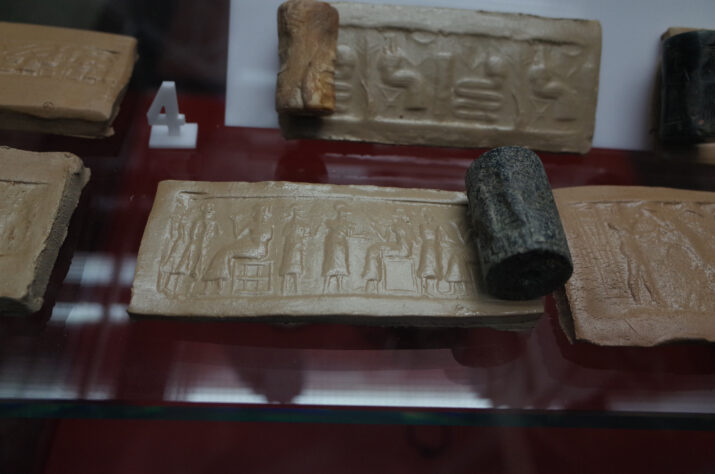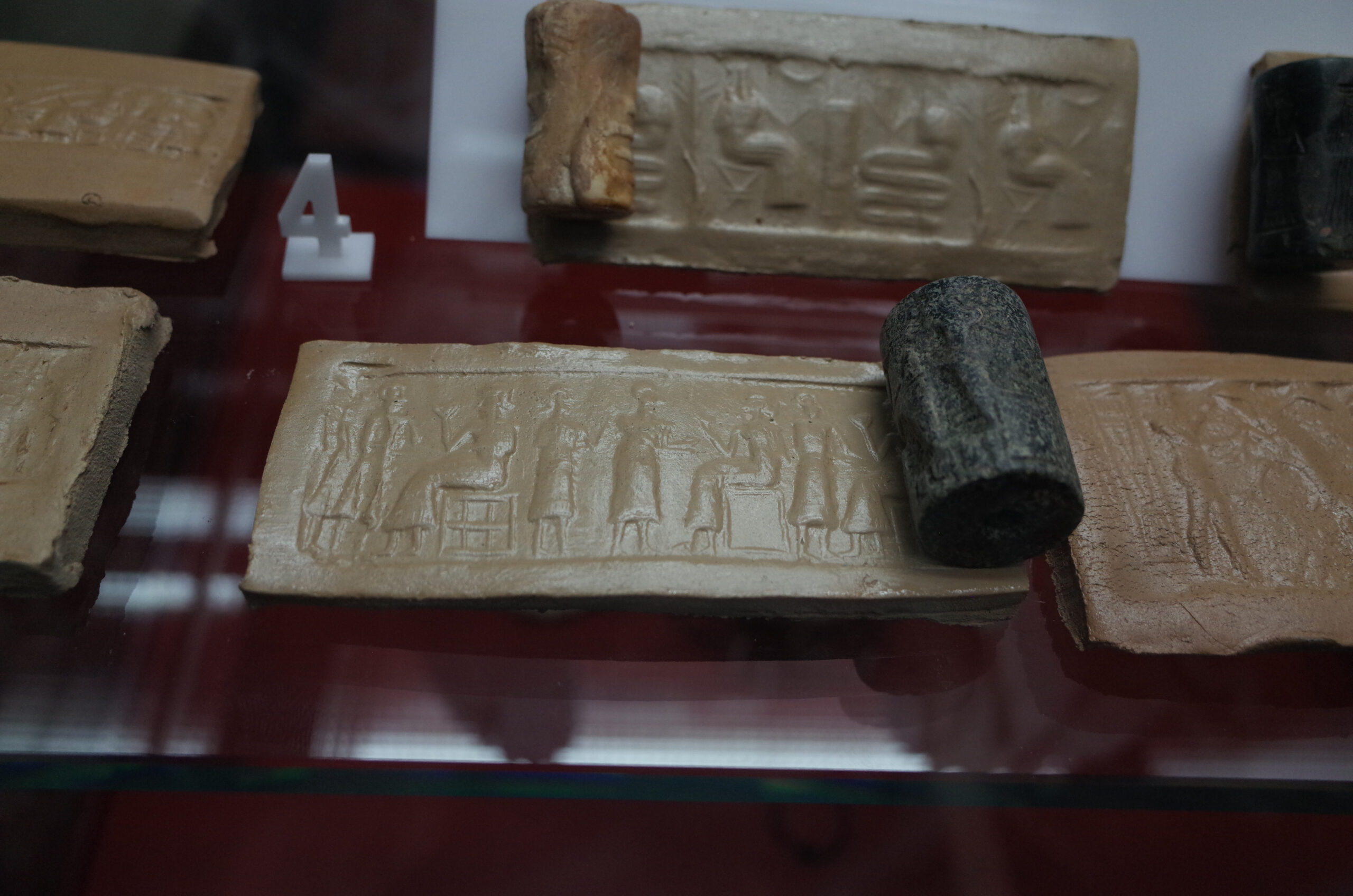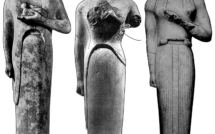
The Cylinder Seal Project: Unveiling the Role of Jean Deshayes in French Mecanography
 This is part of our campus spotlight on Université Paris 1 Panthéon-Sorbonne, with Columbia University.
This is part of our campus spotlight on Université Paris 1 Panthéon-Sorbonne, with Columbia University.
Jean Deshayes was a respected scholar of Near Eastern archaeology, who played a central role in the establishment of the Department of Art History and Archaeology after the creation of the University Paris 1 Panthéon-Sorbonne in 1970. He worked on projects throughout the Near East and helped establish Near Eastern archaeology in French universities, first in Lyon and then in Paris, where he inaugurated the Chair of Near Eastern Studies. In Paris, he went on to become Director of the Department, implementing many changes, for example introducing new courses on methodology, fieldwork, and conservation. He also introduced a multidisciplinary approach, bringing elements of science, chemistry, and new technologies into the teaching of archaeology. His premature death in Tunisia in 1979 was a shock for the department and the field of Near Eastern studies more generally (Huot 1980).
As part of a study on the heritage of the University Paris 1 Panthéon-Sorbonne and of the Institut d’art et d’archéologie in particular, we explored several archives that were left in the department by scholars who worked at the institution in the past. This archival material included documents Deshayes stored in a cardboard box that had never been closely examined since. These documents relate to a “Projet Cylindre” and outline the scholar’s involvement in the Oriental Cylinder Seal Project during his stay at the French Archaeological Institute in Beirut in the mid-late 1950s. This project, led by Jean-Claude Gardin, constitutes an early example of mecanographical analysis in archaeology. Though Deshayes is known less for this latter work than for his subsequent scientific production, the Paris 1 archive shows he played a crucial part in the early stages of the Oriental Cylinder Seal Project. The archive in question consists of one box containing eight folders of Deshayes’s papers, all of them relating to the Oriental Cylinder Seal Project. They reveal his continued interest in the topic in the 1960s, as well as his friendship with Gardin. This interest and friendship would last beyond Deshayes’s direct involvement with the project.
The origins of the Oriental Cylinder Seal Project
The Oriental Cylinder Seal Project began at the French Archaeological Institute in Beirut under the directorship of Henri Seyrig, who acted as a friend and mentor to both Deshayes and Gardin. The two met in Beirut, where Deshayes had conducted research for the CNRS since 1952 and would continue to work until 1961. It was also there that Gardin developed what was to become his quantitative, mecanographical approach to archaeological data (Gardin 1996). Several articles have been written in recent years on Gardin and his very early experiments with quantitative, computer-based archaeology as well as on the reasons why this approach was not taken up by other scientists at the time (see for example Moscati 2013; Ludovico and Camiz 2015; Dallas 2016; Plutniak 2017; Ludovico 2018, and Gardin 1996 & 2002). His work stemmed from a desire to use linguistic analysis and new, computer-based technology to analyze, structure, and facilitate access to what he saw as an increasing amount of disparate data produced by archaeologists. With Seyrig’s backing, a mission was established by the CNRS in 1955 (Moscati 2013, 8), and by 1956 Gardin had come to Beirut to work on a first database to be created on perforated cards (Plutniak 2017, 19). It was to be an inventory of bronze and copper tools emanating from the Balkans to the Indus and dating from the fourth to the second millennium BC; the new inventory was based on an inventory Deshayes had created earlier for his PhD thesis (published as Deshayes and Christophe 1964, reviewed and summarized in Bordaz 1966). Many of the analytical elements that would find their way into Seyrig’s mecanographical approach were already present in Deshayes’s work; indeed, noting the absence of data regarding Bronze Age tools in the Eastern Mediterranean region, the latter had already gathered his own data and found a way to analyze them (Leroi-Gourhan 1962).
Gardin went on to work on several similar projects, on topics ranging from pottery to Greek coins, always in collaboration with an array of colleagues and specialists. He created a methodology and theorized his approach, but his main interest, in line with his background in linguistics, was in the creation of a “code” that would allow the data to be organized and accessed (Gardin 1966, 160-1). It is as a result of Gardin’s collaboration with Deshayes that the Cylinder Seal Project was created, with Seyrig’s support and encouragement. In fact, Gardin attributes the idea of using cylinder seals for this new project to Seyrig (Gardin 1975, 8). Other early contributors to the project include Thomas Beram, a member of the Deutsches Archäolgisches Institut, and Edith Porada, a leading authority on ancient cylinder seals and a professor of ancient Near Eastern art history and archaeology at Columbia University.
The work that was started in Beirut resulted, under Gardin’s leadership, in the creation of the Centre d’Analyse Documentaire pour l’Archéologie (CADA, founded in 1957), a CNRS center dedicated to mecanographic studies. The richest evidence retracing this period is to be found in the documents relating to the CADA in the Archéologie de l’Asie centrale archives at the Maison des sciences de l’homme mondes in Nanterre, where all the documents relating to CADA were sent when the CADA closed in the 1980s. A study of these documents, especially those pertaining to the early years of the CADA, was published in 2013 (Moscati 2013).
The stages of the project seen through the Paris 1 archives
To create a database on the Oriental cylinder seals, the project’s participants decided to limit its scope to include only those seals that had already been the subject of publications. They chose to exclude, however, seals already catalogued in well-known outlets or in reports about sites that were particularly known for their seal collections, as these seals were easy to locate. The aim of the project was thus to facilitate access to what project leaders called the “diaspora” of reports about seals, i.e., those reports published in disparate journal articles and hard to find site reports (Digard 1975, 19). This approach would provide raw data for the project. Moreover, in order to make the archive searchable and therefore accessible, Gardin created a “code,” which he established using Deshayes’s expertise on seals, to translate various aspects of the seals’ imagery and provenance. Deshayes’s role in the creation of the code is well documented in the Paris 1 archive, which provides access to not only the correspondence between the two men—which shows that Gardin submitted potential changes to be made to the code to Deshayes—but also to notes regarding the code itself. These notes were presumably written by Deshayes, but a second, yet unidentified handwriting can also be noticed. Along with other documents already digitized, the notes can today be found on the VERGILIUS portal,[1] the department’s digital repository (see Capozzoli in this spotlight).
The code for the Oriental Cylinder Seal Project went through various versions, several full copies of which can be found in the archives in Nanterre. By 1957, the general architecture of the code seemed to have been established (Gardin 1975, 8: “L’architecturale général du Code trouva dès 1957 la forme qui est aujourd’hui la sienne”). Deshayes’s Paris 1 archive contains two incomplete versions of the code. Neither version is dated, but one of them is clearly anterior, as it contains hand-drawn corrections and additions (fig. 1), which appear in printed form in the later version. It is difficult to known for certain if the drawings are Deshayes’s own. It is also worth noting that in the letters to Deshayes mentioned above, Gardin still discusses changes to the code as late as 1959, suggesting he was still working on it in the early 1960s, ahead of the publication of the work.

Both the work leading up to publication and the involvement of Françoise Digard, who would eventually edit the volumes, are also mentioned in the letters, making clear that she played a key role in the project from an early stage and was closely involved in the analysis of the cylinders. In his letter from January 1959, for example, Gardin mentions that Digard was about to visit Deshayes so they could together go over the changes that Gardin and Digard had just made to the code after Edith Porada published approximately 1,200 seals. He writes that
Françoise is very clear minded, consistent, and rigorous, and I think you will enjoy working with her. She has been attending Labat’s courses on the Akkadian language for several months now, so that within three to four years she will be able to review the inscriptions on the cylinders with a good measure of critical analysis.
This quote suggests that Deshayes did not know Digard well at that time. However, the fact that she worked closely with Gardin on the code continued to be mentioned in later letters. It is most likely that she is the unidentified author of the above-mentioned notes about the code, as the handwriting does not match that of Deshayes or Gardin.
Once the code established, the next phase in the process involved identifying the seals to be included in the study and conducting bibliographical research. It is here that this archive is particularly revealing, as it includes lists of publications, many of which show that items have been crossed out or added; other lists include seals that had been photographed or that needed to be photographed. It appears clearly that Deshayes had undertaken the bulk of the bibliographic work as he sought the seals to be included in the project. As Gardin mentioned, “the ungrateful task of collecting the materials fell mainly to J. Deshayes, who for many months had to go through several hundreds of monographs and periodicals at the French Archaeological Institute in Beirut, searching for the ‘Diaspora’ cylinders” (Gardin 1975, 8). In addition to the lists of publications to be included in the database, the collection includes Deshayes’s reading notes on various volumes. Other sets of documents in the archives account for the ways in which the code should be used; one file contains a few of the forms that Deshayes filled about individual seals to classify them according to the code, and another file contains a limited photo archive.
One archival file is intriguing: it contains a series of lists of Iranian cylinder seals written by Deshayes on official letterhead from the Iranian Ministry of Culture, dating from a time during which the Shah was in power (fig. 2). These lists include the measurements of and the materials used for a number of seals. Judging by the sequence numbers on the lists, the seals seem to correspond to a collection of 495 modern Iranian cylinder seal impressions, which Deshayes also left in the department (see Antinori in this spotlight). It is difficult to establish exactly how these lists relate to the rest of the documents in the archive and to the project as a whole. The seals listed might be seals Deshayes had access to during a trip to Iran, where he worked on the site of Tureng Tepe from 1960 until his death. He might have intended to include these seals in the final project and made the impressions so they could be photographed for the catalogue. Some but not all impressions can be identified based on photos appearing in later publications, and it appears that several seals were not published during Deshayes’s lifetime. Since the focus of the “Oriental Cylinder Seal Project” was on published seals the inclusion of this specific file in the Paris 1 archives remains somewhat mysterious. As Antinori points out in this spotlight, the main issue regarding the relationship between the seal impressions and the Paris 1 archives is the total absence of any publication on the subject by Deshayes. Nor do we know why these lists were written on official letterhead stationery, given that they were clearly personal notes. Further research into the seal imprints and the documents present in the file might clarify this anomaly.

Finally, the last and perhaps most interesting category of documents in the archival file relates to the continued work of the CADA and to the correspondence between Gardin and Deshayes. In this file, there are five letters written by Gardin and addressed to Deshayes between 1959 and 1965, all of which have been published on VERGILIUS. As mentioned above these letters mainly concern the code and later changes that Gardin submitted to Deshayes before making them. Also present in the archive are several reports of minutes of CADA meetings that took place between 1964 and1966 and that were sent by Gardin to Deshayes to keep him abreast of changes to the project. These minutes include, for example, discussions about which publications should or should not be included in the project. In a 1965 letter, Gardin mentions that Deshayes had just become a member of the CADA committee. However, a handwritten note at the top of a CADA document detailing the state of the project in 1966 shows that the report was sent to Deshayes by Gardin, suggesting that by that time Deshayes was no longer participating directly in the project. In fact, by 1958, Digard had taken over Deshayes’s responsibilities in the project (Gardin 1975, 8). However, the fact that Gardin submitted changes to the project to Deshayes after that date suggests that the latter continued to be seen very much as an expert, a friend, and someone who still had a say in the future of the project. By this point, Deshayes had left Beirut and was working in Lyon—where he taught from 1961 to 1968—and it is worth noting that although the last document in the file relates to 1966, Deshayes took the documents with him when he moved to Paris in 1968. They were still stored in the department when he died in 1979, four years after the publication of the project.
The final publication, the Répertoire analytique des cylindres orientaux: publiés dans des sources bibliographiques éparses (sur ordinateur) emerged in 1975, edited by Digard. A booklet promoting the publication, today kept at the CADA archives in Nanterre, gives us an indication of the final numbers of seals included in the project:
The corpus includes ca. 4,000 cylinders located “in scattered bibliographical sources,” essentially periodicals and other serial publications, scanned as much as possible from the inception year to 1960 (about 160 titles), and monographs of various kinds (excavation reports, etc., ca. 150 titles), excluding the major catalogues.
The final output was composed of three volumes. The first, Principles and Results, includes 198 fac-similes of computer printouts, the second the code, and the third a commentary. A series of cards containing information on each seal are also included. Owners of the published volumes could request a copy of the file, to be provided to them on magnetic tapes.
The Cylinder Seals Project and the archive today: communication and potential uses
In studying the departmental archive, priority was given to understanding and re-contextualizing it. The archive had already been divided into folders by Deshayes. Because the archive had been organized by Deshayes himself and was logical, his organization was retained in the uploading of content onto the VERGILIUS digital portal. For the most part, we also used the title of each file as presumably labeled by Deshayes, even when there were uncertainties about the meaning. The next step was to digitize and transcribe the letters, as it was thought that they would give the most valuable insight into the project, Deshayes’ role, and his relationship with Gardin. The second priority pertained to the CADA documents, the notes relating to the code, and the part of the code showing how it had evolved over time. Eventually, the digitization of the whole code as it existed at the time might be helpful, as we could compare it to the final version published in 1975. Deshayes’s bibliography to be included in the project is also a compelling, if more specialized, aspect of his work, which might appeal to anyone wanting to explore the history of the project and Deshayes’s work in more detail.
A larger question regarding the legacy of this project emerges. As previously mentioned, there has been a recent surge in interest in Gardin’s work and the potential lessons of his mecanographical projects. Newer, updated attempts at similar projects are underway, and researchers are fully aware of these lessons (see for example, Ludovico 2018). One of these lessons is the obvious issue of technology and how to create a database that is going to remain usable and relevant. When Digard’s publication appeared in 1975, the original perforated cards, which could be used without any additional technology by simply stacking them and identifying where the perforations matched, had been transposed to microfilm for ease of use, a move that seemed logical at the time but that today makes access much harder. The Paris 1 archives do not contain any of the original perforated cards (although at least one version of these cards can be found in Nanterre), but it does contain the lists of texts from which the cards are drawn. The additional information concerning the discussions on the code itself and how it evolved over time could also be of interest in re-establishing the history of the project and to engage in a more detailed discussion of the methodology used. Further research into the topic, through the Paris 1 archives, can therefore only be beneficial.
Finally, it is interesting to see that Gardin himself broke down the process of creating the code into four stages, which Moscati described (2013, 11). Each stage requires a decreasing amount of specialization:
-
- Stage 1: establish an analytical code according to which the descriptions will be made;
- Stage 2: write the descriptions according to the code;
- Stage 3: create the perforated index cards and the cards to be included in the corresponding catalogue; and
- Stage 4: possibly make duplicates of the cards to disseminate parts or all of the files.
The second stage necessitates, as Moscati notes, knowledge of the materials, but not necessarily the tournure d’esprit required for the first stage, i.e., the element dearest to Gardin. Clearly, Gardin approached his role—that of breaking down the images into a code—as the crucial stage in the process, and the archive reveals the degree to which the breakdown entailed cooperating with Deshayes. The archive also highlights Deshayes’ role in the second, less theoretical—although perhaps more time-consuming phase of the project. No less crucial was Digard’s contribution; her work also deserves highlighting, even though there is less evidence of it in the Paris 1 archive. Finally, we would like to return to the reasons for which the code was not adopted or complemented by academics. Once central reason, of which Gardin was already aware, was that
The basic hurdle for the future use and expansion of the catalogue, the value of which is evident from a methodological and practical point of view, was the unlikely availability of scholars willing to dedicate their own time and energies to a project that would not provide them with a personally fruitful outcome (Ludovico 2018, 88).
The Paris 1 archive illustrates this latter point perfectly, as it sheds light on the time-consuming work that lies behind the construction of projects such as the Oriental Cylinder Seal Project. It is telling that despite Deshayes’s otherwise illustrious career, his name is rarely mentioned in discussions on the legacy of that project and other contemporary projects.
Mariana Silva Porto is a PhD candidate at both Humboldt University in Berlin and University Paris 1 Panthéon-Sorbonne. She holds degrees from the universities of Glasgow, Cambridge, and Paris.
Mathilde Castéran holds a Master’s degree in cultural heritage and museum studies from the University Paris 1 Panthéon-Sorbonne.
References
Bordaz, Jacques. 1966. “Index de l’Outillage (sur cartes perforées). Outils en métal de l’âge du Bronze, des Balkans à l’Indus. Jacques Christophe and Jean Deshayes. Paris, Centre National de la Recherche Scientifique, 1964.” American Anthropologist, 1554–1556.
Dallas, Costis. 2016. “Jean-Claude Gardin on Archaeological Data, Representation and Knowledge: Implications for Digital Archaeology.” Journal of Archaeological Method & Theory 23, 305–330.
Deshayes, Jean and Christophe, Jacques. 1964. Index de l’outillage: outils en métal de l’âge du bronze, des Balkans à l’Indus, Paris.
Digard, Françoise. 1975. Répertoire analytique des cylindres orientaux: publiés dans des sources bibliographiques éparses (sur ordinateur), 3 vol., Paris.
Gardin, Jean-Claude. 1966. “Le Centre d’Analyse Documentaire pour l’Archéologie.” Revue Archéologique, 159–163.
Gardin, Jean-Claude. 1975. “Introduction”, in Françoise Digard, Répertoire analytique des cylindres orientaux: publiés dans des sources bibliographiques éparses (sur ordinateur), 3 vol., Paris.
Gardin, Jean-Claude. 1996. “Une archéologie moderne: les initiatives d’Henri Seyrig.” Comptes rendus des séances de l’Académie des Inscriptions et Belles-Lettres 140, 1013–1018.
Gardin, Jean-Claude. 2002. “Les modèles logico-discursifs en archéologie.” Archeologia e Calcolatori 13, 19–30.
Huot, Jean-Louis. 1980. “Nécrologie: Jean Deshayes (1924-1979).” Syria 57, 497–502.
Leroi-Gourhan, André. 1962. “Jean Deshayes, Les outils de bronze, de l’Indus au Danube (IVe au IIe millénaire), I et II (Institut français d’Archéologie de Beyrouth. Bibliothèque archéologique et historique, t. LXXI), 1960.” Revue des Études Anciennes 64, 148–149.
Ludovico, Alessandro di 2018. “Data Description and the Integrated Study of Ancient Near Eastern Works of Art: The Potential of Cylinder Seals”, in Alessandro di Ludovico et al. (eds), CyberResearch on the Ancient Near East and Neighboring Regions: Case Studies on Archaeological Data, Objects, Texts, and Digital Archiving. Brill, Leiden-Boston, 85–110.
Ludovico, Alessandro di and Camiz, Sergio. 2015. “Art History of the Ancient Near East and Mathematical Models: An Overview”, in François Giligny et al. (eds), CAA 2014. 21st century Archeaology: Concepts, Methods and Tools. Archaeopress, Oxford, 29–34.
Moscati, Paola. 2013. “Jean-Claude Gardin (Parigi 1925-2013). Dalla meccanografia all’informatica archeologica.” Archeologia e Calcolatori 24, 7–24.
Plutniak, Sébastien. 2017. “L’innovation méthodologique, entre bifurcation personnelle et formation des disciplines: les entrées en archéologie de Georges Laplace et de Jean-Claude Gardin.” Revue d’histoire des sciences humaines 31, 113–139.
[1] https://vergilius.pantheonsorbonne.fr/collections/show/378
Photo: Shutterstock | Basra, Iraq | Sumerian clay cuneiform tablets and cylindrical stamps.
Published on November 21, 2023.




